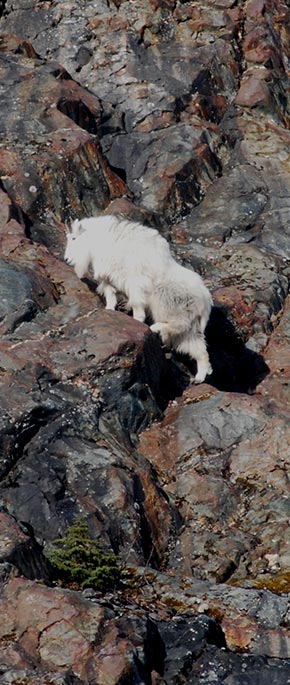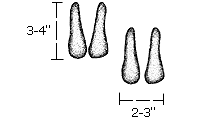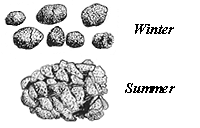Mountain Goat
(Oreamnos americanus)
Printer Friendly
Did You Know?
Mountain goats are confused with Dall sheep, but goats have black horns, and there are no Dall sheep in Southeast Alaska. Mountain goats are more tolerant of the wetter coastal climates than Dall sheep.
General Description
Mountain goats inhabit rugged, mountainous habitats in western North America. In Alaska, mountain goats occur in coastal regions in southeastern and south-central Alaska. Mountain goats were not described in the scientific literature until 1816 and remain one of the least-studied large mammals in North America. They are sometimes confused with Dall sheep, but sheep are not typically found in coastal Alaska (generally prefering drier country). Nonetheless, in some small areas of Alaska mountain goats and Dall’s sheep occur on the same mountains (i.e., Kenai Mtns–Cooper Landing, Turnagain Arm–Penguin Ck., Knik Glacier, Wrangell/St. Elias–McColl Ridge).
The mountain goat (Oreamnos americanus) is the single North American representative of a unique group of mountain ungulates called the Rupicaprinae, or “rock goats.” They are characterized by having relatively short horns and a fondness for living in rugged terrain. Mountain goats are one of two species of all-white, hoofed, large mammals found in Alaska.
Mountain goats are easily distinguishable from Dall sheep by their black horns. These creatures are well adapted for extreme winter conditions and have a long, shaggy winter coat. A crest of long, erect hair up to eight or more inches in length runs along the spine, on the rump, and over the shoulders and neck. Long hairs on the legs give the appearance that the goat is wearing pantaloons. Mountain goats begin shedding their winter coat in June, with adult males and sub-adults shedding-out before females. By July, their soft, sleek summer coat is grown in. When the first winter snows dust the high country in mid-October, mountain goats have fully grown their winter coats again.
The appearance of both sexes is much alike except that males are about 40% larger than females and have differently shaped horns. Adult female goats weigh about 180 pounds, with males averaging about 280 pounds (in late-summer); prime-aged males often weigh more than 300 pounds, with the largest male yet weighed topping 385 pounds. The horns of an average adult female are equal in length to those of an average adult male but are more slender and bend back more sharply at the tip. Mountain goat hooves are specially designed for climbing in steep, rock, and slippery terrain. A close-up look reveals a hard keratinous sheath and a soft embedded pad that enable goats to gain purchase on the smallest of granite cracks while simultaneously gripping maximum surface area.
Life History
Growth and Reproduction
The breeding season for mountain goats occurs between late October and early December. Billies (males) may travel considerable distances in search of receptive females (nannies). Mountain goats have a polygynous mating systems, meaning that males will breed with multiple females but not vice versa. Typically, prime-aged males (5-10 years old) do most of the breeding, with some battling among males causing occasional horn-inflicted puncture wounds. Adult males usually separate themselves from larger nanny-kid nursery groups except for during the rut. They may form small bachelor groups, especially in summer. Females, on the other hand, tend to stay in groups along with kids and immature animals. This behavior is particularly evident during mid-summer when large nursery bands form.
Usually a single kid is born in mid-late May after a gestation period of approximately 180 days. Twinning occurs rarely. Nannies seek out rugged, isolated sites prior to giving birth but soon join other nannies with newborn kids to form nursery groups. Kids remain with their mothers until the next breeding season and often for some years beyond. Interestingly, mountain goats will not give birth until they are 4 years of age; this is quite old compared to female moose, black-tailed deer, and caribou. Mountain goats may live up to 18 years, but most live less than 12.
Feeding Ecology
Mountain goats are both grazing and browsing animals depending on the particular habitat and season of the year. They normally summer in high alpine meadows where they graze on sedges, forbs, and low-growing shrubs. As winter advances, feeding habits generally shift to browsing. Blueberry, hemlock, and lichen can be important winter diet items, but feeding habits in winter center on availability.
Range and Habitat
Mountain goats occupy remote habitat and are therefore the least studied large mammal in North America. The mountain goat’s range is restricted to the steep and broken mountain ranges of northwestern North America, from the northern Cascade and Rocky mountains to Southcentral Alaska. In Alaska, mountain goats occur throughout the southeast Panhandle with their range continuing north and west along the coastal mountains to Cook Inlet. In Southcentral Alaska they are generally confined to the Chugach and Wrangell mountains, although small numbers of goats have been documented in the Talkeetna Mountains. Mountain goats have also been introduced to non-native range on Kodiak and Baranof Islands where populations have expanded, on Chichagof Island where the transplant apparently failed, and most recently on Revillagigedo Island where goats are now firmly established. Mountain goats on Baranof Island are an interesting case study because recent genetic data indicate that mountain goats may have occurred on the island since the last ice age in a "cryptic refugia" and the 1923 transplant was an augmentation to the existing population rather than a true introduction.
Goats in coastal areas exhibit altitudinal migrations from alpine summer ranges to winter ranges at or below tree line, typically in old-growth forest habitats. In more interior areas, mountain goats will winter on windswept ridges as long as forage areas remain uncovered by snow.
Status, Trends, and Threats
Status
Mountain goat populations are highly sensitive to severe winter conditions and human harvest, particularly when harvest rates of female mountain goats are high. In addition, mountain goat populations are often small and geographically isolated. As a result, mountain goat population trends throughout Alaska vary considerably from place to place and from year to year.
Overall, there are estimated to be 24,000–33,500 mountain goats in Alaska. A majority occur in southeast Alaska (13,500–20,000) though the Cordova area (3800–4400), Kenai Peninsula (3300–4750) and Kodiak Island (1700–2000) also considerable numbers of mountain goats. Peripheral areas such as the Wrangell Mountains (700) and northern Chugach mountains (Anchorage area = 600–700, Knik Glacier = 150–160, NE Chugach = 200) have smaller populations. The Talkeetna Mountains has a very small, isolated populations of 30–40 animals.
Over the 10-yr period between 2000-2009 an average of 485 mountain goats were per year. The highest harvest occurred in southeast Alaska (162) and Kodiak island (129). A substantial amount of annual harvest also occurs on the Kenai peninsula (78) and the Cordova/PWS area (64). Other areas such as the Gulf Coast (20) and northern Chugach mountains (38) have relatively low harvest, due to small populations or geographic isolation.
Threats
Winter snowfall is one of the most important factors influencing mountain goat (and all ungulates) populations in Alaska. High snowfall can result in substantially reduced survival of adult mountain goats. Since adult survival is the most important influencing population dynamics, severe winters can result in significant population declines. In the Lynn Canal area, detailed research has documented a 45% decline during a 5-year period dominated by several severe winters. Since mountain goats have relatively low reproductive rates, it often takes several years for populations to rebound once winter conditions moderate.
Harvest of female mountain goats represents another threat to mountain goat populations. In most places in Alaska females can be legally harvested through the practice is strongly discouraged. Harvest of females can be sustainable is low proportions are harvested but nonetheless reduced harvest opportunity for harvest of males. If female harvest rates are high, population declines can occur and has occurred in places such as the Kenai peninsula and Baranof island.
Timber harvest in low elevation, forested mountain goat winter range is relatively limited in Alaska. Nonetheless, the practice has occurred in the past and can effect mountain goat populations by reducing the amount of habitat available for mountain goats during the critical winter season.
Relative to other wildlife species, mountain goats are particularly sensitive to industrial disturbance activities such as helicopter overflights and blasting. In coastal Alaska, helicopter tourism (flight-seeing in summer, helicopter skiing in winter) is an increasingly popular activity and management agencies are particularly concerned about its effects of mountain goat populations. Industrial activities such as mining, road construction and hydroelectric development also have the potential to have detrimental effects on mountain goat populations.
Fast Facts
-
Size
Up to 385 pounds. -
Distribution
Throughout Southeast Alaska, along coastal mountains and into Southcentral. -
Diet
Sedges, forbs, low-growing shrubs, blueberries, hemlock, and lichen. -
Predators
Wolves, bears. -
Reproduction
Single kid is most common; twinning is rare. -
Remarks
Mountain goats are sure-footed climbers and have specially adapted hooves for climbing in rough, slippery terrain. Mountain goats are among the most charismatic species and inhabit one of the most spectacular landscapes on earth.
Did You Know?
- Mountain goats are confused with Dall sheep, but goats have black horns, and there are no Dall sheep in Southeast Alaska. Mountain goats are more tolerant of the wetter coastal climates than Dall sheep.
- Most of the world’s mountain goats are found in Southeast Alaska and British Columbia.
Uses
Mountain goat viewing
Mountain goats are an iconic species of the northern mountains and represent a highly sought after wildlife viewing experience of local residents and visitors to the state of Alaska. Often seen in dramatic mountain landscapes, the species is very photogenic and captivating. While it might seem that watching mountain goats requires strenuous journeys deep into the remote backcountry, this is not necessarily the case. For example, in Alaska’s capital city of Juneau mountain goats can been seen with binoculars or spotting scopes from the downtown cruise ship dock — how many other capital cities can afford wildlife enthusiasts a comparably exhilarating experience?
Mountain goats are particularly interesting animals to watch. They are highly social (especially females) and form “nursery groups” comprised on adults, sub-adults and kids in summer. Sometimes such groups can number 40–50 animals (though typically 8–12) and often feature very entertaining bouts of playful behavior among kids. Mountain goats are also master climbers and can be observed navigating breathtakingly steep and rugged terrain with impressive gymnastic ability.
There are many excellent places to watch mountain goats near most coastal Alaskan communities. Some of the more popular places include:
Southeastern Alaska
- Juneau: Mt Juneau (from downtown or Gold Ck. Trail), Mendenhall Glacier
- Ketchikan: Deer Mountain trail
- Haines: Chilkoot Lake, Mt. Ripinsky Trail, Haines Highway
- Sitka: Blue Lake
- Tracy Arm: Sawyer Glacier (boat accessible only)
- Glacier Bay: Mt. Wright, Gloomy Knob (boat accessible only)
Southcentral Alaska
- Kenai Peninsula: Exit Glacier, Cooper Landing
- Kodiak: Barometer Mountain trail
- Anchorage/Girdwood: Crow Pass
- Cordova: Saddlebag Glacier trail
More Information
Native weaving and carving
The native inhabitants of the North Pacific coast of Alaska have traditionally used the hide, horns and other parts of mountain goats to create extraordinary works of art with deep cultural significance. Chilkat and Ravenstail blankets are traditionally woven from mountain goat hair (and cedar bark — in the case of Chilkat blankets). The hair is collected from hides harvested in the spring or by collecting shed wool in early-summer. The wool is meticulously processed and, in some cases, dyed using natural plant materials prior to being woven on looms in intricate designs. Blanket weaving requires exceptional skill and traditional knowledge and is practiced by a uniquely devoted group of traditional weavers, some of whom are internationally recognized for their accomplishments. Mountain goat horns are also carved into ceremonial spoons and engraved with intricate designs.
Mountain goat hair is highly valued by traditional weavers. If you find mountain goat hair while hiking in the mountains and would like to donate it to weavers, if will be highly appreciated. Your local ADFG office can put you in contact with local weavers.
Subsistence and sport hunting
Alaska natives have a long tradition of hunting mountain goats for food, hides and ceremonial purposes dating back thousands of years. Even today, in many rural communities local residents rely on mountain goats as a key source of sustenance, particularly in places where other species (such as deer, moose or caribou) are absent or uncommon. Mountain goats are also highly prized by sport hunters and in many places qualified guides will accompany hunters from around the world for “once in a lifetime” opportunities to hunt mountain goats. Mountain goat hunting is very difficult and requires an uncommon degree of dedication, tenacity and, crucially, preparation. Mountain goats hunters represent a unique segment of the hunting community as a result of these requirements.
Management
Populations are monitored by aerial surveys or incidental to Dall sheep surveys in South-central Alaska. Harvest information is obtained through a mandatory hunt report that is part of a required registration permit. Information collected includes the areas and numbers of days hunted, hunter success, dates of hunts and kills, transport methods, and commercial services used.
In most areas, goat harvest is managed using a weighted point harvest system, where males equal one point and females equal two points. For example, in southern Southeast Alaska, take is managed so that harvest does not exceed six points per 100 goats. Thus, the harvest of males can be twice the harvest of females. This provides more opportunity for hunters and assures a productive and sustainable goat population.
Mountain goats don’t reproduce as early, or have as many offspring, as deer and moose. Although deer and moose have young at two and three years of age, respectively, mountain goats do not give birth until they are four or five years old. And while moose and deer often have twins, twinning is rare for mountain goats. This low productivity means that individual female mountain goats are very important to the overall population. It can take years to replace one harvested female goat.
ADF&G is working to educate hunters about mountain goats, and produced a mountain goat identification guide to help hunters identify male (billy) and female (nanny) goats. The free 48-page guide features dozens of color pictures highlighting the many subtle clues that distinguish nannies from billies.
Finer-scale mountain goat management continues to be necessary in some areas as hunting pressure increases. With the guideline harvest being approached in several areas in the past few years, ADF&G may soon implement a sealing requirement to assure accurate reporting of male and female goats. In some areas hunters are also asked to voluntarily provide their goat horns to Fish and Game office for aging.
Research

The Alaska Department of Fish and Game has been conducting research on mountain goats since the 1970s. Research projects serve an important role relative to conservation of the species in Alaska. It's not easy (nothing is easy with mountain goats!), but dedicated research efforts pay big dividends and provide critical field data used to identify critical habitat, estimate population size and composition, determine survival and reproductive rates, articulate population and landscape genetic patterns, assess disease status, characterize diet and nutritional condition and develop new tools for understanding the species biology.
The web links below will enable you to explore the various dimensions of the Alaska Department of Fish and Game mountain goat research program.
Mountain Goat Research Section
Contents
More Resources
General Information
- Mountain Goat — Wildlife Notebook Series (PDF 54 kB)
- Game Transplants in Alaska, Mountain Goats (pp. 16-32) (PDF 5,001 kB)
- Mountain Goat Trails — Research and Management Update for Southeast Alaska (PDF 2,375 kB)
Alaska Fish and Wildlife News
- Managing Mountain Goats in Alaska
- Mountain Goats in Focus: Biologists Share Management and Research
- Mountain Goats: Mysteries and Management
Mountain Goat Hunting
Wildlife Viewing
Management & Research Reports

Mountain Goat Tracks



